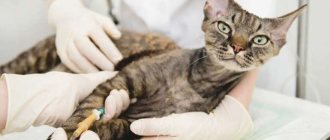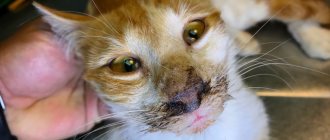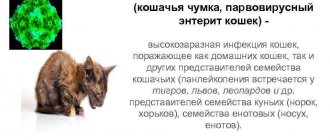Hypothermia is a condition characterized by a decrease in the cat’s body temperature below 37.0 C° as a result of the predominance of the process of heat transfer from the body over the process of heat production. Described by the medical term "hypothermia". Why might the temperature drop?
A decrease in body temperature in a cat can be caused by:
- Impact on the body of low ambient temperature, cold.
- Long-term operations on the chest and abdominal organs (more than 3 hours), prolonged anesthesia (more than 4 hours).
Animals with various types of injuries, endocrine diseases of the adrenal glands and thyroid glands, diseases of the cardiovascular and nervous systems. The influence of internal factors on the thermoregulation center of the brain. These factors include:
- head injuries, cancer and congenital brain diseases,
- accumulation in the body of various harmful substances as a result of illness (for example, diabetes or kidney failure),
- entry into the body of substances that act on the nervous system.
Kittens are very predisposed to a decrease in body temperature due to imperfect thermoregulation mechanisms.
What does it look like?
A decrease in body temperature causes behavioral and physiological reactions in cats aimed at maintaining it. Cats tend to lie down in a warm place and curl up into a ball. The fur becomes ruffled, which increases the air gap between the external air and the skin. Muscle tremors appear, resulting in the formation of additional heat.
There is a narrowing of blood vessels on the surface of the body (peripheral vasospasm), which reduces heat loss from the surface of the skin. At the same time, the skin and visible mucous membranes become paler and cooler; the mucous membranes resemble “white marble” in color.
Hypothermia (hypothermia) in cats: symptoms and treatment
Everyone knows that staying in the cold for a long time without good clothes is not worth it - at best, such neglect of basic safety measures can result in frostbite of the limbs, and in the worst case, death. The same is absolutely true for our smaller brothers, including cats. If a cat stays in extreme cold for a long time, everything can end sadly, as hypothermia in cats is fraught with serious consequences.
First aid
The cat should be placed in a well-heated room, wrapped in a blanket or covered with heating pads with warm water (water temperature 38-40 ° C). Offer your cat a warm drink, such as broth or milk. It is necessary to periodically measure your pet's body temperature.
When urgent qualified veterinary care is needed
If the body temperature drops below 36° C and continues to decrease, it means that the body’s defense mechanisms have been exhausted, heat loss increases sharply and progressive cooling of the body occurs. It is accompanied by signs of depression, including loss of consciousness. The trembling disappears. The pulse becomes weak or absent. Breathing is shallow and rare. Heartbeats are difficult to detect and their frequency is sharply reduced. Serious heart rhythm disturbances develop. A further decrease in temperature is accompanied by severe disorders of the body's functions and its death. The cat requires timely, qualified assistance, which can only be provided in a veterinary clinic under the constant supervision of a doctor. The cat should be wrapped in a warm wool blanket, warm heating pads applied to the body, and immediately taken to a veterinarian for intensive care.
What will the doctor do?
The scope of treatment depends on the degree of cooling of the body. In case of severe hypothermia, in addition to warming, the injured animal needs intensive therapy, aimed not only at correcting existing disorders of the functions of organs and systems, but also at preventing possible complications. The main efforts are focused on maintaining adequate breathing, effective blood circulation, optimal metabolism, preventing further cooling and gradual active warming of the body.
It goes without saying that it is necessary to direct maximum efforts to identify and eliminate the cause of the decrease in body temperature. In case of respiratory and cardiac arrest, it is necessary to carry out the entire complex of resuscitation measures. During treatment, body temperature, blood pressure and changes in the electrocardiogram are constantly monitored. The outcome of hypothermia depends on its cause, severity, the previous condition of the affected animal and the time elapsed before treatment.
There is evidence that older animals that experience hypothermia have residual brain damage that makes them more susceptible to repeated hypothermia. It should be noted that in case of hypothermia, very long (several hours) resuscitation measures can be successful, therefore, declaring the death of an animal with hypothermia is justified only after it has been warmed to 30-32°C. However, profound metabolic disorders that develop both as a result of hypothermia and prolonged resuscitation can subsequently cause fatal complications (cerebral edema, cardiovascular failure). Understanding the subtle mechanisms that develop during hypothermia, timely diagnosis, initiation of treatment and preventive measures, as well as adequate and reasoned intensive therapy for hypothermia will prevent the development of severe complications and improve treatment outcomes for such patients.
Frostbite is local damage to body tissues, including necrosis, associated with prolonged exposure to low temperature (cold), accompanied by the development of local, and in some cases general, pathological reactions. The extreme degree of frostbite is hypothermia and freezing.
What is hypothermia?
Hypothermia is a severe pathological condition that is caused by a decrease in the cat's body temperature below the minimum acceptable level . Note that the normal body temperature of a healthy adult cat varies from 38 to 39°C. In kittens, this indicator ranges from 38.5 to 39.5°C, with short-term jumps up to 40°C being acceptable. This is due to the imperfection of their thermoregulation center, which has not yet had time to “tune in.”
The main physiological mechanism that is triggered when an animal or person is cold is involuntary muscle contraction (shivering) . Since the body of cats is covered with fur (although not in all breeds), they suffer less from the cold than humans, but still they are very far from the animals of the Arctic.
The maximum risk of developing hypothermia is created in conditions when it is not only cold outside, but also humid. If the animal's fur is moistened, there is no air gap between the hairs, resulting in the cat being “naked . In this condition, your pet is especially susceptible to developing hypothermia. What other categories of animals are most likely to develop this pathological condition?
These are the oldest cats and small kittens. Due to age (excessively large or small), their thermoregulation system malfunctions and cannot maintain a stable body temperature. That is why “oldies” and small kittens should always be kept in comfortable conditions. It is generally not advisable to let old cats outside in winter and autumn.
Can a cat freeze?
Cats are less likely than dogs to get frostbite. Wool protects cats well from the cold. The cat is a domestic animal and rarely goes outside. Outdoor cats hide in basements, attics, hallways and other warm places. However, no one is safe from freezing in winter. At very low air temperatures (for domestic cats this is -10 -20 C° and below), some peripheral parts of the body may freeze. For example, the tips of the ears, paws, the tip of the tail. As a result, local tissue damage occurs - frostbite . The lower the temperature affecting problem areas, the faster they freeze. This is also facilitated by fatigue, fasting, blood loss, injury, compression by a bandage or tourniquet.
The situation becomes significantly worse if:
- In winter, the cat's fur gets wet or it falls into the water. In this case, the wool loses its heat-protective function and the animal quickly freezes,
- We are talking about small kittens whose thermoregulation function is still poorly developed,
- the mammary glands are greatly enlarged in a pregnant (second half) or lactating cat,
- Cats of exotic breeds (Sphynxes and other hairless cats), as well as all short-haired breeds, are exposed to prolonged exposure to cold.
Symptoms of hypothermia
What are the symptoms of hypothermia in cats? They largely depend on how far the pathological process has progressed. In most cases, the following clinical signs can be observed:
- Severe and uncontrollable shaking . But it only happens in mild cases of hypothermia. So if you notice that your pet is literally “shaking” from the cold, you can consider him lucky.
- If you put your hand on the skin on a cat's belly, you can feel the cold coming from it. Since the abdomen and groin area are usually the warmest under normal conditions, this simple test is very revealing.
- Apathy , the cat tries to hide in the farthest corner and does not come out, even to eat.
- Lethargy.
- Drowsiness.
- Decreased rectal temperature . This is a very dangerous symptom, since under normal conditions the temperature in the rectum is approximately 0.5-1°C higher than when measured in the ear or mouth. This is observed only in severe forms of hypothermia, in which case it is strongly recommended to immediately show the animal to an experienced veterinarian.
- Slow and shallow breathing.
- Slow heartbeat (bradycardia).
- Inappropriate behavior.
- Coma.
- Death.
Basic principles of first aid
First of all, you need to place the animal in a warm room and wrap it in a blanket. Warming of the affected part of the body should be gradual, slow, mostly passive. It is unacceptable (!) to rub frostbitten areas with hands, tissues, alcohol, and even more so with snow! (Such recipes are extremely tenacious and are still popular among the people.) The fact is that these measures contribute to the formation of blood clots in the vessels, deepening the processes of destruction (destruction) of the affected tissues.
Apply a thermally insulating cotton-gauze bandage (7 layers) to the affected part of the body to accumulate heat and prevent premature warming of the surface tissues (and, accordingly, the formation of a temperature difference between the superficial and deep-lying tissues). The use of a thermal insulating bandage makes it possible to slow down the external warming of the affected area several times while ensuring general warming of the body
According to the shape of the ears, you can sew earphone bags that are attached with ties. You cannot bandage your ears by pressing them to your head! As a result of circulatory disorders, necrotic processes can develop.
Warming up after frostbite is accompanied by moderate pain, sensitivity and temperature are restored.
Attention : frostbitten areas remain highly sensitive to cold for a long time, are easily subject to repeated frostbite and therefore in the future need especially reliable protection!
Treatment of frostbite
Warm frostbitten areas by immersing them in warm (not hot) water for 20 minutes, or until the tissue turns red. Never use snow or ice. Tissue damage increases significantly if thawing is followed by freezing. Do not rub or massage the affected parts because the damaged tissue is easily destroyed. Your cat should see a veterinarian as soon as possible. Antibacterial therapy may be prescribed to prevent secondary infections.
Once sensation returns to the frostbitten areas, the cat may experience pain. Don't let your cat over-groom or lick these areas.
Treatment of hypothermia in cats and dogs in a veterinary clinic
What diagnostics may be needed?
- General blood test (it will reveal the degree of inflammation, the state of the red blood, whether there is anemia or not).
- Biochemical blood test (will help assess the function of internal organs).
- X-ray (will show the condition of the lungs, the degree of their damage, as well as the condition of the bone tissue).
- Ultrasound examination (will help check the structure of the abdominal organs).
Hypothermia and hyperthermia
Thermoregulation
Hypothermia
Pathophysiology
Cardiovascular changes: bradycardia, arterial hypotension, cardiac arrhythmias, decreased cardiac output and asystole. Initially, tachycardia and hypertension are observed. As hypothermia worsens, arterial vasodilation progresses, leading to hypotension and decreased cardiac output. (1) Respiratory effects: first, an increase in respiratory rate, then a decrease in the frequency and depth of breathing, trauma to the pulmonary alveoli, hypoxia of all body tissues. Slowing metabolism results in decreased CO2 production, thereby decreasing minute ventilation. Reduced motility of the ciliated epithelium creates favorable conditions for the development of pulmonary edema, bronchopneumonia and acute respiratory distress syndrome. (1)
Neurological effects:
from minor depression to coma. Hypovolemia, vasoconstriction of peripheral vessels, a leftward shift in the oxygen-hemoglobin saturation curve, and decreased liver function are all cold-induced abnormalities that are responsible for the development of lactic acidosis. (5) Due to reduced perfusion, acute renal failure, pancreatitis, and erosions of the gastrointestinal mucosa may develop. Both hypoglycemia and hyperglycemia, as well as hypo- and hyperkalemia, may occur. Hypocoagulation, disseminated intravascular coagulation syndrome, as well as leukopenia and thrombocytopenia may occur. (5)
Antiarrhythmic drugs and catecholamines should not be used in cases of moderate to severe hypothermia because, even if the body responds to them, the response will be unpredictable. In addition, most pathological manifestations are eliminated only by increasing body temperature and correcting electrolyte and acid-base disorders. (2) Regardless of the method used, body temperature should rise at least 1–2 ºC per hour, and active rewarming should be stopped when body temperature reaches 37 ºC to prevent the development of rebound hyperthermia. (2) When measured rectally, the patient's body temperature may continue to fall for a period of time after rewarming begins. This phenomenon is caused by the return of cold peripheral blood to the central circulation and the movement of warm blood from the center to the periphery. In cases of severe peripheral vasoconstriction, passive superficial rewarming should always be accompanied by active internal rewarming to reduce the temperature difference between the central and peripheral circulation. During external rewarming, take precautions to prevent skin burns, e.g. adjust the temperature of the external heating devices themselves or place a thermal barrier between the heat source and the patient. (3) The evaluation and management of a patient with hypothermia should be the same as for any critically ill patient. Monitoring must be as thorough as possible. The method and technique of rewarming are based on the severity, duration and predisposing causes of hypothermia. (5)
- Passive external rewarming: The animal is covered with blankets to prevent heat loss and allow the body to produce heat itself. In general, this method is useful for patients with mild hypothermia who are otherwise healthy.
- Active external warming: the animal is wrapped and external heat sources are applied. This method is typically used to rewarm moderately hypothermic animals, malnourished animals with mild hypothermia, and animals that have not responded to passive rewarming.
- Active internal warming: peritoneal dialysis with a warm solution, warm lavage of the pleural space, lavage of the stomach or colon, warming of inspired air. Used in animals with a temperature less than 30°C, in animals with cardiac arrest due to hypothermia, or in animals that do not respond to other methods of rewarming.
People with a temperature less than 33.9 °C experience severe pain during rewarming, which is also observed in animals. After the temperature reaches 36.7 °C, it is recommended to administer narcotics to relieve pain. (5)
Treatment at home: what medications can be given?
There are no special medications to treat colds in cats. Veterinarians recommend treating the disease with drugs that boost immunity and relieve symptoms. During therapy, the pet needs to be provided with comfortable living conditions, proper nutrition and rest.
Antibiotics
Colds in cats are treated with antibiotics when bacterial infections occur. Drugs must be selected with caution. Not only the recovery, but also the life of the pet depends on this. The most commonly prescribed medications for cats are:
- oxytetracycline;
- gentamicin;
- amoxicillin;
- chloramphenicol;
- kanamycin.
It is important to correctly calculate the dose of the drug, which depends on the weight, age and general condition of the cat’s body. For colds in cats, treatment at home involves following the administration regimen drawn up by the doctor. Otherwise, the drug is ineffective. The course of antibacterial therapy lasts 7-10 days. You should not interrupt treatment, even if the symptoms disappear after 3-4 days. If you refuse further administration of antibiotics, the infection may become chronic.
Injections
Both antibiotics and immunostimulating agents are injected. The administration of vitamins has a positive effect on the cat's condition. If the cold is severe, the animal can be treated with interferon. The product has a high price and has a number of side effects. It can be replaced with immunoglobulins - antibodies obtained from a recovered animal. They act only in the first days of illness. It is recommended to give injections to your cat at a veterinary clinic.
Nasal rinsing
The procedure helps clear the nasal passages of mucus secretions and restore breathing. For this purpose the following drugs are used:
Therapeutic techniques
If the injured cat is outside, it must be brought indoors immediately . The goal is to slowly warm up a frozen animal. It is strongly not recommended to rush and speed up the warming process.
Treatment for mild hypothermia can be described as "passive warming." If the cat reacts adequately enough to what is happening, it has basic reflexes, you can simply leave it in a warm room. Make sure that there are no drafts and that there is no cold blowing from the floor. If for one reason or another it is not possible to arrange a “steam room” in the room, you can simply wrap the animal in a blanket or rug. It’s even more effective when heating pads or simple plastic bottles filled with warm water are placed there. Please note that all such “heaters” must be wrapped in cloth in order to minimize the risk of burns.
It is very important to dry your pet's coat immediately (if it is wet). To do this, use a regular hairdryer, which in no case should be set to maximum temperature! It should also not be pressed directly onto the cat’s skin (it is best to “blow” the fur from a distance of 5-7 cm).
Monitor your cat's body temperature at least every ten minutes. As soon as it reaches at least 37.2°C, you can offer the animal a small amount of food and drink. Please note that it is strongly recommended that you call your veterinarian at this time. The fact is that prolonged exposure to excessively fresh air is very dangerous for cats. Sometimes the consequences of such a walk include pneumonia and meningitis, so it is better to be on the safe side in advance.
Moderate and severe cases of hypothermia require veterinary monitoring. Please note that the animal must be warmed throughout the journey to the doctor ; for this you can use either a regular heating pad or special medical blankets (if you can get them). When treating severe and even moderate cases of hypothermia, warming the cat is done not from the outside, but from the inside . For this, warm enemas, heated formulations for intravenous administration, inhalation of steam or simply warm air can be used. If the animal becomes more or less “adequate”, it is given warm liquids.
Throughout treatment, it is very important to constantly monitor the condition of the heart . If necessary, drugs are administered to enhance and support cardiac activity. In addition, even after the main signs of hypothermia have disappeared, it is advisable to leave the cat with the veterinarian for a couple of days: during this time, urine and blood samples are taken from the animal. This is done to exclude or confirm possible damage to internal organs (especially the kidneys). It is not so rare for a cat to end up with hypothermia.
When urgent qualified veterinary care is needed
If you notice skin lesions
In frostbitten areas of the skin, sensitivity is either slightly retained or not at all, but terrible pain remains. The animal licks the sore spot, thereby promoting the development of infection and the appearance of wet, weeping wounds.
If necrosis or gangrene (death of areas of the skin that no longer have a blood supply) develops, the doctor may decide to remove the affected area.
If there is a change in consciousness
Body temperature progressively decreases, and signs of depression appear or the animal is in an unconscious (shock) state. These are serious signs of hypothermia in the animal's body.
When breathing changes
The occurrence of shortness of breath - rapid breathing, or, conversely, a sharp slowdown in breathing, can also indicate the need for urgent help for the animal.











